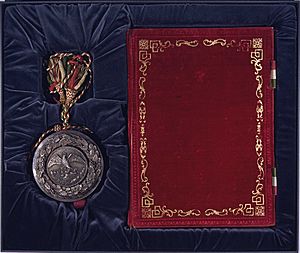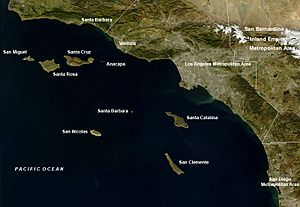Aboriginal title in California facts for kids
Aboriginal title in California refers to the original land rights of the indigenous peoples of California. These are the rights Native American groups had to their lands before European settlers arrived. California is special because the United States never signed formal treaties with its Native American tribes. This means all Indian reservations in the state were created by federal laws or special orders from the President.
California has had fewer lawsuits about these land claims compared to other states. This is mainly because of the California Land Act of 1851. This law, passed after the Mexican–American War, said that anyone claiming land from Spanish or Mexican grants had to file their claim within two years. Several important court decisions later said this law also applied to Native American land rights. Since no tribes filed claims under this Act, courts decided that their original land rights were ended.
Contents
History of Land Rights
Early Times in California
Before European settlers, Native American groups lived all over California. They had their own ways of life and used the land for many things.
Spanish Rule
Spain arrived in California and set up 21 missions. Many Native Americans, called Mission Indians, lived and worked at these missions. However, most of California's Indigenous people (around 80%) still lived outside the missions. Spanish law generally recognized the traditional land rights of Indigenous peoples.
Mexican Rule
Mexico became independent from Spain in 1824. Mexico then closed the mission system. Some Native American tribes were given ownership of their lands during this time.
California Becomes U.S. Territory

In 1848, Mexico gave California to the United States after the Mexican–American War. The Treaty of Guadalupe Hidalgo said the U.S. would respect land grants given by Spain and Mexico.
That same year, gold was found in California. This brought many new people to the area very quickly. During this time, U.S. government reports often played down the land rights Native Americans had under Spanish and Mexican rule.
California Becomes a State
California became a U.S. state on September 9, 1850. The law that made California a state did not mention Native American land rights.
The Unapproved Treaties
Soon after California became a state, the U.S. government tried to make treaties with California tribes. Three commissioners were sent to negotiate. By 1852, they had negotiated 18 treaties with about a third of the state's tribes. These treaties aimed to create Indian reservations.
However, California's state leaders strongly opposed these treaties. They wanted Native Americans to be moved out of the state completely. Because of political disagreements in Congress, none of the 18 treaties were ever approved. They were kept secret for many years.
Federal agents had already convinced many Native Americans to move to these proposed reservations while the treaties were waiting. Without the treaties, these communities faced terrible conditions. Their population dropped sharply due to hunger, sickness, and violence.
The Land Claims Act of 1851
On March 3, 1851, Congress passed the California Land Act of 1851. This law required anyone claiming land in California based on Mexican grants to file their claim within two years. If a claim was approved, the person would get a special document called a patent. Lands not claimed or approved would become public land.
Two years later, another law was passed to survey these public lands. This law specifically said it did not apply to "land in the occupation or possession of any Indian tribe." It also allowed the President to create five military reservations for Native American purposes.
The effect of these laws on Native American land rights in California has been debated for over 150 years. The U.S. government never again tried to make treaties with California Native Americans. Instead, it used laws and executive orders to create reservations. By 1986, Presidents had used this power to create 117 reservations, covering about 632,000 acres.
Court Cases for Land Claims
In 1927, California passed a law allowing the Attorney General of California to bring land claims on behalf of the tribes. The next year, Congress allowed the United States Court of Claims to hear these cases. Earl Warren, who later became a famous Chief Justice, argued one of these cases in 1941. The court found that the government was responsible but did not award interest on the money. Warren negotiated a $5 million settlement for the tribes. Later, under a different law, the same tribes settled for $29 million.
How the Land Claims Act Affected Land Rights
Early California Court Decisions
The California Supreme Court first looked at how the Land Claims Act applied to Native Americans in Thompson v. Doaksum (1886). The court ruled against the Native Americans, saying they should have filed a claim under the Act.
However, two years later, in Byrne v. Alas (1888), the court changed its view. It ruled in favor of a group of Mission Indians. The court said that if a third party had proven ownership of land, it meant that land was not public. Therefore, the Native Americans' original land rights were not ended. The court also said that Congress probably did not mean for Native American rights to be lost just because they didn't file claims.
Important U.S. Supreme Court Rulings
Barker v. Harvey (1901)
In 1901, the U.S. Supreme Court heard a case called Barker v. Harvey. This case involved Mission Indians who had lost their land in a lawsuit. The Court ruled that even perfect land ownership was subject to the Land Claims Act. It also said that the Act itself ended original Native American land rights if no claims were filed. The Court also looked at the specific land grants and decided that the Native Americans had given up their claim to the land before California became part of the U.S.
United States v. Title Ins. & Trust Co. (1923)
More than 20 years later, the Court looked again at its Barker decision in United States v. Title Ins. & Trust Co. (1923). The government sued on behalf of Mission Indians who had a Mexican land grant from 1842. The Court decided not to change its earlier ruling from Barker. It said that many people had relied on that decision when buying land in California. Changing it now would cause many problems.
Super v. Work (1926)
In Super v. Work (1926), members of the Karuk and Peh-tsick tribes challenged the building of dams in California. They said the dams would violate their original land rights and their rights under the Treaty of Guadalupe Hidalgo. The court ruled that both rights were ended by the 1851 law. The U.S. Supreme Court agreed with this decision.
United States ex rel. Chunie v. Ringrose (1986)
In 1986, a court case called United States ex rel. Chunie v. Ringrose involved the Chumash people and their claim to the Channel Islands of California. The court decided that even though the Chumash's original land rights survived Mexican land grants, these rights were lost because the tribe did not file a claim under the Land Claims Act. The court looked at the earlier rulings in Barker, Title Insurance, and Super and applied their rules.
Individual Land Rights
What are Individual Aboriginal Rights?
Sometimes, a single Native American or a family might have a right to occupy a specific piece of land, even if their tribe's overall land rights were ended. This is called "individual aboriginal title."
Cramer v. United States (1923)
In Cramer v. United States (1923), the Supreme Court looked at land that was supposed to be for Native American reservations but was later given to railroads. The court said that all land grants are generally given with the understanding that Native American land rights might exist.
The Court also said that the 1851 Land Claims Act did not apply to the Native Americans in this case. This was because their claims were not based on Spanish or Mexican grants, and it wasn't clear if they were occupying the land when the Act was passed. The Court ruled that if Native Americans were using and living on land with the government's implied permission, no government official could take that land away from them.
United States v. Dann (1989)
United States v. Dann (1989) further explored individual land rights. In this case, even though the tribe's overall land rights were ended, the court found that individuals could prove they had individual land rights based on their use of the land before certain government rules were put in place. However, the court also said that it is now much harder for an individual Native American to gain new land rights just by occupying public land, as government policies have changed since the time of the Cramer case.
Proving individual land rights is often difficult in court. It requires showing that a person's ancestors lived on and used a specific piece of land for a very long time, and that these rights were never taken away.
See Also



